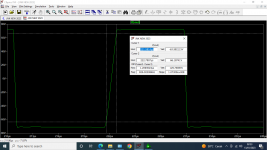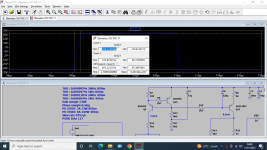thank you ,,,The data you need is in Diff (Cursor2-Cursor1): 129.76953V/1.2093023us = ~107.3V/us
sorry I'm still learning to use ltspice,
for this one how to get SR 97/us?The data you need is in Diff (Cursor2-Cursor1): 129.76953V/1.2093023us = ~107.3V/us
Attachments
I didn't spot that ltspice already computed for us the slope, aka slew rate. 😳
Here 59.389786V/641.22137ns = slope = 9.26189E7 V/s =92.26189V/us
I don't know how spice computes 97V/us. Perhaps the peak rate is a bit higher that the average shown graphically, but the concept is the same. The graph portrays what you'd see on a scope if you made a physical measurement.
Here 59.389786V/641.22137ns = slope = 9.26189E7 V/s =92.26189V/us
I don't know how spice computes 97V/us. Perhaps the peak rate is a bit higher that the average shown graphically, but the concept is the same. The graph portrays what you'd see on a scope if you made a physical measurement.
Last edited:
It's not a matter of LTspice. Its the same when you read a scope. The definition of slew rate is volts per sec (or usec). So if you see a voltage change of 60V during a 641nS time step, that's a slew rate of 60V per 641nS which from basic calculation is 60V/0.641us or 93V/1uS.thank you ,,,
sorry I'm still learning to use ltspice,
Jan
Saya tidak melihat bahwa ltspice sudah kemudahannya, alias tingkat perubahan tegangan. 😳
Di sini 59.389786V/641.22137ns = kemiringan = 9.26189E7 V/s =92.26189V/us
Saya tidak tahu bagaimana rempah-rempah menghitung 97V/us. Mungkin tingkat puncaknya sedikit lebih tinggi dari rata-rata yang ditampilkan secara grafis, tetapi konsepnya sama. Grafik yang menggambarkan apa yang akan Anda lihat pada ruang lingkup jika Anda melakukan pengukuran fisik.
It's not a matter of LTspice. Its the same when you read a scope. The definition of slew rate is volts per sec (or usec). So if you see a voltage change of 60V during a 641nS time step, that's a slew rate of 60V per 641nS which from basic calculation is 60V/0.641us or 93V/1uS.
Jan
thanks for the enlightenment sirIt's not a matter of LTspice. Its the same when you read a scope. The definition of slew rate is volts per sec (or usec). So if you see a voltage change of 60V during a 641nS time step, that's a slew rate of 60V per 641nS which from basic calculation is 60V/0.641us or 93V/1uS.
Jan
- Home
- Amplifiers
- Solid State
- calculate SR in ltspice

